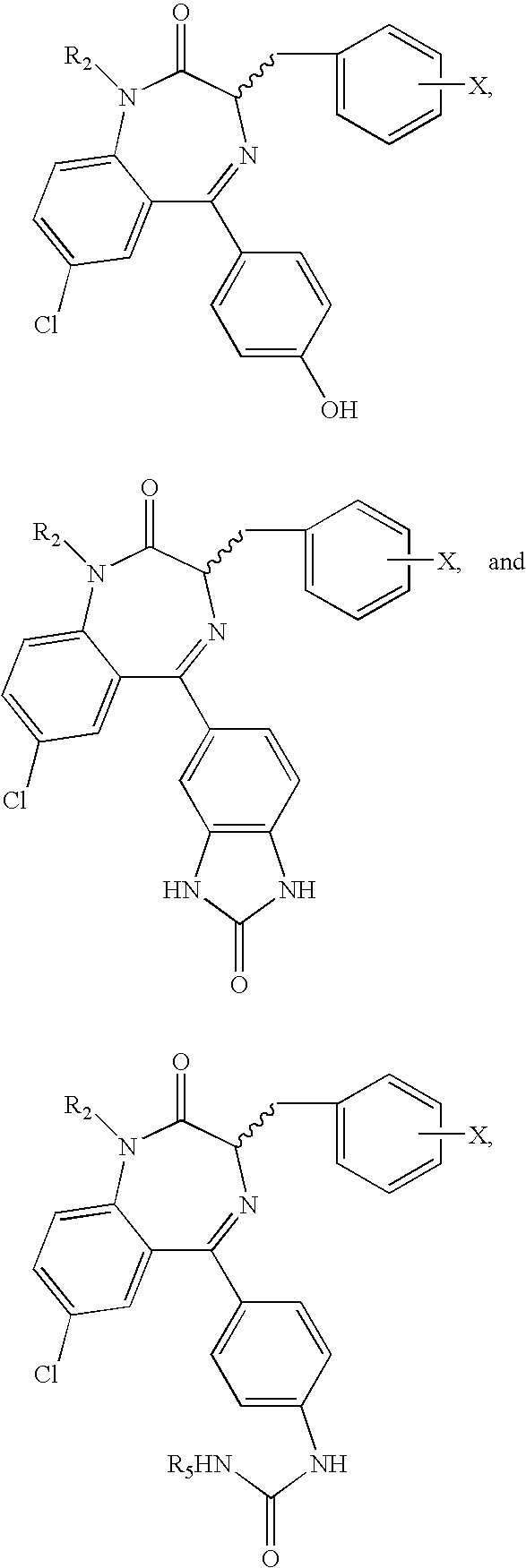Compositions and methods relating to novel compounds and targets thereof
a technology of novel compounds and compounds, applied in the field of benzodiazepine compounds, can solve the problems of limiting efficacy, serious drawbacks of existing cytotoxic chemotherapeutic agents, and serious deleterious effects in the organism, and achieve the effect of rapid identification and easy identification of monoclonal fab fragments
- Summary
- Abstract
- Description
- Claims
- Application Information
AI Technical Summary
Benefits of technology
Problems solved by technology
Method used
Image
Examples
example 1
Representative General Procedures for Synthesis of Benzodiazepine Cores
Part I:
[0269]
6-Chloro-1-methyl-1H-benzo[d][1,3]oxazine-2,4-dione (Compound B where R═CH3). In a 3 L, 3 neck RBF equipped with mechanical stir, addition funnel, thermocouple and N2 inlet, NaH (30.4 g) was suspended in anhydrous THF (400 mL). While stirring at room temperature, a suspension of 5-chloroisotonic anhydride in THF (400 mL) was added in portion-wise manner over 45 min. The reaction mixture was stirred for 50 min (reaction temperature went up from 18 to 28° C.). To this was added CH3I (285 g, 125 mL) over 15 min. The mixture was then stirred at 42° C. for 16 h. Because TLC showed that some unreacted starting material was still present in the reaction mixture, an additional 30 mL of CH3I was added and the reaction mixture stirred at 42° C. for an additional 3 h. Reaction mixture was cooled (RT) and quenched by the slow (40 min) addition of AcOH (55 mL). Reaction mixture was concentrated to give 275 g thic...
example 2
Representative General Procedure for Simultaneous Synthesis of the Benzodiazepine Core and Installation of C3 Functionality
[0274]
7-Chloro-3-(2-chlorobenzyl)-3,4-dihydro-1H-benzo[e][1,4]diazepine-2,5-dione. 2-Amino-3-(2-chlorophenyl)propanoic acid hydrochloride (3.0 g, 12.7 mmol) was suspended in acetonitrile (50 mL) and water (5 mL), triethylamine (3.57 mL, 25.4 mmol) was added which caused a precipitate to form and inefficient stirring. Water (10 mL) was added until all solids were dissolved. 5-Chloroisatoic anhydride (2.51 g, 12.7 mmol) was added in portions, waiting until each portion dissolved before adding the next. Successive portions required longer periods of time, up to 15 minutes for the last portions. After the last portion was added, the suspension was sonicated for several minutes then stirred at ambient temperature overnight. The clear solution was concentrated in vacuo then azeotroped twice with acetone. The residue was redissolved in acetic acid (30 mL) and heated to...
example 3
Representative General Procedures for Synthesis of (E)-5,7-Dichloro-benzodiazepin-2(3H)-one Intermediate
[0276]
(E)-5,7-Dichloro-3-(2-chlorobenzyl)-1-(4-methoxybenzyl)-1H-benzo[e][1,4]diazepin-2(3H)-one. 7-Chloro-3-(2-chlorobenzyl)-1-(4-methoxybenzyl)-3,4-dihydro-1H-benzo[e][1,4]diazepine-2,5-dione (0.65 g, 1.43 mmol) was suspended in anhydrous toluene (10 mL) under a nitrogen atmosphere. N,N-Dimethylaniline (0.36 mL, 2.9 mmol) was added followed by phosphorus oxychloride (0.20 mL, 2.1 mmol) and the mixture was heated at 90° C. for 4 hours. After cooling to ambient temperature, the mixture was diluted with 40 mL of ethyl acetate:hexanes (1:2), washed with ice water (10 mL), ice cold 1 M hydrogen chloride (2×10 mL), and brine, then dried with sodium sulfate, decanted and concentrated in vacuo. The residue was redissolved in a small amount of ethyl acetate, then poured onto a silica plug. The product was eluted with 100 mL of ethyl acetate:hexanes (1:2) to yield (E)-5,7-dichloro-3-(2-ch...
PUM
| Property | Measurement | Unit |
|---|---|---|
| time | aaaaa | aaaaa |
| temperature | aaaaa | aaaaa |
| temperature | aaaaa | aaaaa |
Abstract
Description
Claims
Application Information
 Login to View More
Login to View More - R&D
- Intellectual Property
- Life Sciences
- Materials
- Tech Scout
- Unparalleled Data Quality
- Higher Quality Content
- 60% Fewer Hallucinations
Browse by: Latest US Patents, China's latest patents, Technical Efficacy Thesaurus, Application Domain, Technology Topic, Popular Technical Reports.
© 2025 PatSnap. All rights reserved.Legal|Privacy policy|Modern Slavery Act Transparency Statement|Sitemap|About US| Contact US: help@patsnap.com



